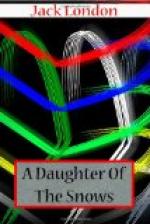As he grew older he modified these concepts, but the process was a continual source of naive apprehension and wonderment. It was not until he became a man and had wandered through half the cities of the States that this expression of childish wonder passed out of his eyes and left them wholly keen and alert. At his boy’s first contact with the cities, while he revised his synthesis of things, he also generalized afresh. People who lived in cities were effeminate. They did not carry the points of the compass in their heads, and they got lost easily. That was why they elected to stay in the cities. Because they might catch cold and because they were afraid of the dark, they slept under shelter and locked their doors at night. The women were soft and pretty, but they could not lift a snowshoe far in a day’s journey. Everybody talked too much. That was why they lied and were unable to work greatly with their hands. Finally, there was a new human force called “bluff.” A man who made a bluff must be dead sure of it, or else be prepared to back it up. Bluff was a very good thing—when exercised with discretion.
Later, though living his life mainly in the woods and mountains, he came to know that the cities were not all bad; that a man might live in a city and still be a man. Accustomed to do battle with natural forces, he was attracted by the commercial battle with social forces. The masters of marts and exchanges dazzled but did not blind him, and he studied them, and strove to grasp the secrets of their strength. And further, in token that some good did come out of Nazareth, in the full tide of manhood he took to himself a city-bred woman. But he still yearned for the edge of things, and the leaven in his blood worked till they went away, and above the Dyea Beach, on the rim of the forest, built the big log trading-post. And here, in the mellow of time, he got a proper focus on things and unified the phenomena of society precisely as he had already unified the phenomena of nature. There was naught in one which could not be expressed in terms of the other. The same principles underlaid both; the same truths were manifest of both. Competition was the secret of creation. Battle was the law and the way of progress. The world was made for the strong, and only the strong




